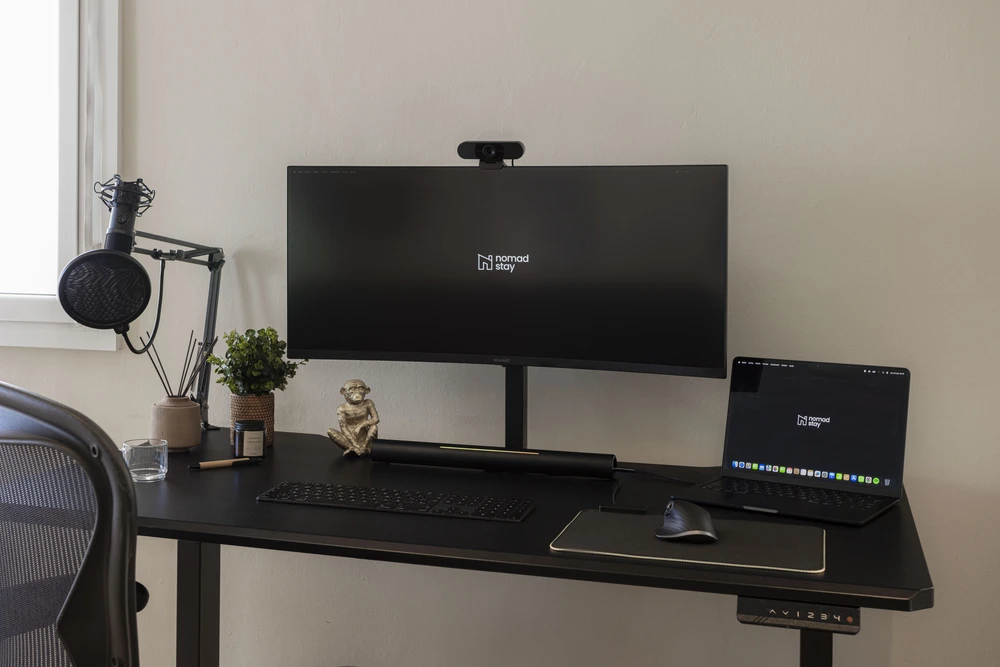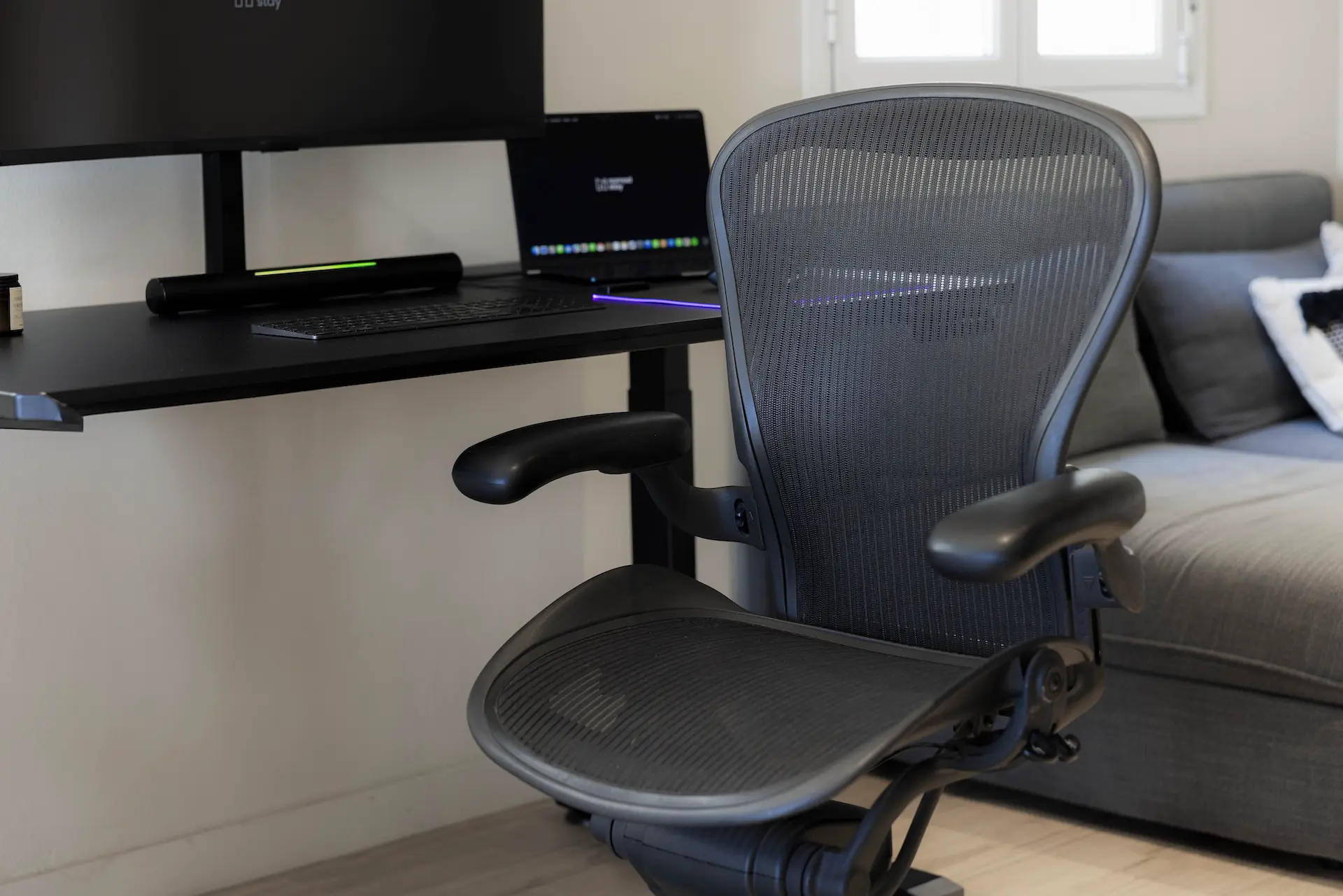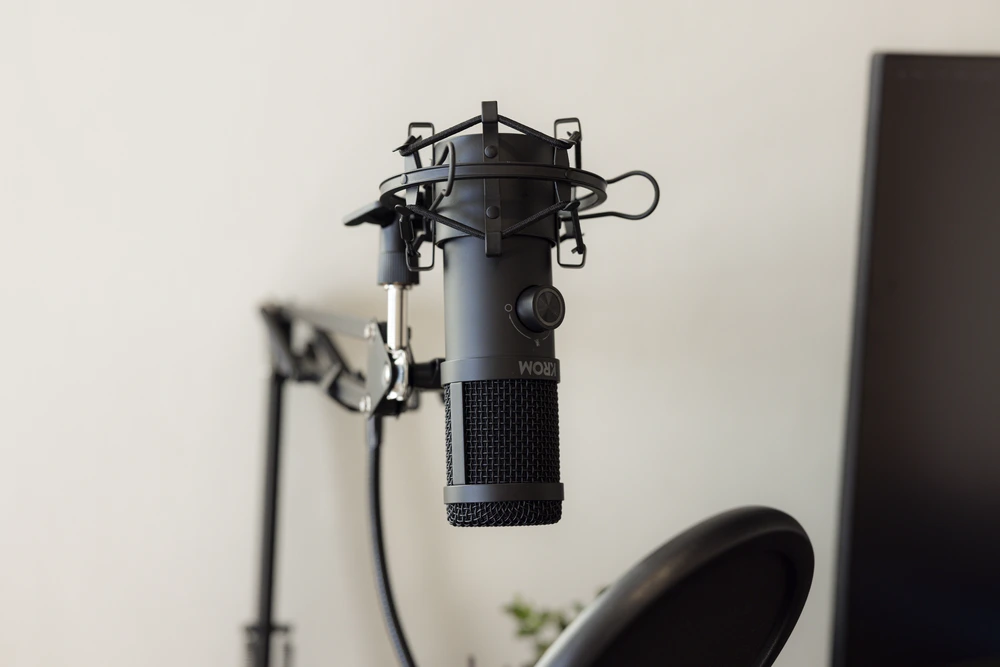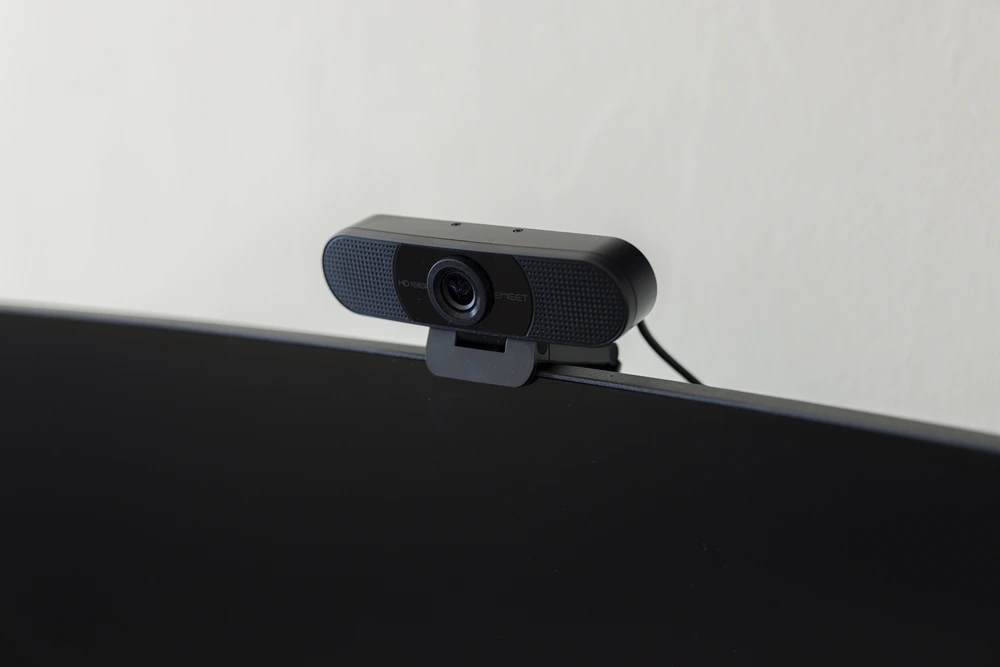7 Essential Items for Your Remote Work Travel Setup
Discover 7 essential items for your remote work travel setup to enhance productivity and make working from anywhere a breeze.
7 Essential Items for Your Remote Work Travel Setup
Want to work from anywhere? Here's exactly what you need in your mobile office:
| Item | What You Need | Starting Price |
|---|---|---|
| 1. Laptop | MacBook Air M3 or Dell XPS 13 | $1,099 |
| 2. Laptop Stand | Roost or Nexstand K2 | $39.99 |
| 3. Keyboard/Mouse | Logitech MK850 combo | $99.99 |
| 4. Noise-Canceling Headphones | Sony WH-1000XM5 | $398 |
| 5. Power Adapter | Ceptics 65W World | $55 |
| 6. Power Bank | Anker 747 (25,600 mAh) | $149.99 |
| 7. Mobile Hotspot | Netgear Nighthawk M6 | $649.99 |
Quick Facts:
- Battery life: Pick devices that last 10+ hours
- Internet speed needed: 50+ Mbps for video calls
- Weight limit: Keep total gear under 5 pounds
- Power: Get adapters that work with 110V-240V
Before You Buy:
- Check trip length - longer trips need more backup gear
- Know your destination's power socket types
- Test internet speeds where you'll stay
- Consider time zones for work hours
I've tested this setup across 6 countries over 5 years. This gear works everywhere from beach cafes to mountain cabins.
Related video from YouTube
1. Good Laptop
A solid laptop makes or breaks your remote work setup. Here's what the top performers offer in 2024:
| Model | Battery Life | Weight | Starting Price |
|---|---|---|---|
| Dell XPS 13 (2024) | 19:41 hrs | 2.6 lbs | $1,299 |
| MacBook Pro 16" (M3 Max) | 18:20 hrs | 4.8 lbs | $2,499 |
| MacBook Air (M3) | 15:13 hrs | 2.7 lbs | $1,099 |
| HP OmniBook X | 16:22 hrs | 2.9 lbs | $1,099 |
Want to pick the RIGHT laptop? Here's what matters:
Battery Life: You need 10+ hours of REAL use. The Dell XPS 13 (2024) crushes it with almost 20 hours of web browsing.
Size & Weight: 13-14 inch screens hit the sweet spot. The MacBook Air M3 nails it at 2.7 pounds - light enough to carry, big enough to work on.
Build: Metal bodies last longer. MacBooks and Dell XPS use aluminum that can take a beating.
Core Specs You Need:
- Latest Intel/AMD or Apple M-series chip
- 16GB RAM (don't go lower)
- 512GB SSD minimum
- Multiple USB-C/Thunderbolt ports
Power: Get a laptop that handles both 110V and 220-240V. You'll thank yourself when traveling.
Bottom line? The MacBook Air (M3) hits the perfect balance. Work all day on a single charge, carry it anywhere, and never worry about speed.
Need Windows instead? The Dell XPS 13 (2024) matches the MacBook Air's stats and runs Windows - perfect if your company needs PC software.
2. Laptop Stand
Here's what the best laptop stands offer in 2024:
| Model | Weight | Height Range | Price |
|---|---|---|---|
| Roost Laptop Stand | 170g | 6-12 inches | $89.99 |
| Rain Design iLevel 2 | 680g | 6.5-8.5 inches | $59.99 |
| Nexstand K2 | 234g | 5.5-13 inches | $39.99 |
| MOFT Invisible | 140g | 2-3.5 inches | $29.99 |
When picking a travel stand, three things matter:
- Pack Size: The Roost folds to water bottle size (1" x 1.5" x 13")
- Weight Capacity: Nexstand K2 holds 20lbs - works for ANY laptop
- Quick Setup: Look for snap-lock mechanisms, not screws
"The iLevel 2 beats other stands we tested for quick height adjustments." - Ben Frumin, Wirecutter editor in chief
Materials & Build:
- Pick aluminum over plastic
- Check for rubber grip pads
- Make sure it can handle heat
Getting the Height Right: Your screen should sit just above eye level. Most people need 6-8 inches of lift. If you use a standing desk, go for 12+ inches of range.
Bottom Line: The Roost stands out for remote work. It's light, compact, and lifts your screen perfectly. Plus, the aluminum build keeps it safe in your bag.
Want to save money? Try the Nexstand K2. It's like the Roost but costs 50% less. The build isn't as premium, but it works just fine.
3. Wireless Keyboard and Mouse
Here's what you need to know about wireless keyboard and mouse options in 2024:
| Model | Weight | Battery Life | Price | Key Features |
|---|---|---|---|---|
| Logitech MX Keys Mini | 1.1 lbs | 10 days (backlit), 5 months (no backlight) | $99.99 | 3-device pairing, mic mute |
| Logitech K380 | 0.93 lbs | 24 months | $39.99 | 3-device support, compact size |
| Arteck HB030B | 0.5 lbs | 6 months | $29.99 | Backlit keys, Bluetooth |
| Logitech MK850 | 1.8 lbs | 36 months (keyboard), 24 months (mouse) | $99.99 | Ergonomic design, Flow technology |
Let's break down what makes these devices work:
Power Options The K380 uses AAA batteries - perfect for long trips without charging access. Want fewer cables? The MX Keys Mini comes with USB-C charging. If you work in bright spaces, solar-powered options like the MK750 might be your best bet.
Size & Portability For backpack-friendly options, stick to keyboards under 1 lb. Skip the number pad (go "tenkeyless") to save space. Need something TINY? The iClever BK06 folds down to just 6.5 x 4.0 inches.
"The second-gen Keys To Go design is an improvement in every way." - PCWorld
Connectivity You've got options:
- Bluetooth: Better battery life + works with more devices
- USB receiver: Stable connection but uses a USB port
- Multi-device: Switch between your gear with a button press
Mouse Features That Matter
- DPI settings for different surfaces
- Extra side buttons for shortcuts
- Power switch to save battery
Bottom line? The Logitech MK850 works best for daily tasks - it connects to 3 devices and comes with both keyboard and mouse. Need something light? Go for the K380 keyboard. It's under a pound and runs for 2 years on regular batteries.
4. Headphones with Noise Canceling
Here's what you need to know about the best noise-canceling headphones for remote work in 2024:
| Model | Price | Battery Life | Key Features |
|---|---|---|---|
| Focal Bathys | $699 | 30 hours | Premium build, multi-device support |
| Apple AirPods Max | $529 | 20 hours | Smart switching for Apple devices |
| Bose QuietComfort Ultra | $429 | 29 hours | 87% noise reduction, multi-point |
| Sony WH-1000XM5 | $398 | 30 hours | 4 mics per earcup, quick charge |
| Sennheiser Momentum 4 | $299.95 | 36 hours | Clear calls, foldable design |
| Beats Studio Pro | $199.95 | 24 hours | Apple/Android compatible |
| Anker Soundcore Life Q30 | $79 | 44 hours | Budget pick, 95% low-freq reduction |
Let's break down what matters:
Battery Life: The Anker Q30 tops the list at 44 hours. Most others last about 30 hours - enough for a full work week. Need a quick boost? The Sony WH-1000XM5 gives you 3 hours of use after just 3 minutes of charging.
Noise Blocking: Each model handles noise differently:
- Bose QuietComfort Ultra cuts 87% of background noise
- Sennheiser ACCENTUM blocks 90% of high-frequency sounds
- Anker Q30 reduces 95% of low-frequency noise
Device Switching: Working remotely means juggling devices. The Bose QuietComfort Ultra connects to your phone and laptop at the same time - perfect for switching between work calls and music.
Portability: Need to move around? The Sennheiser Momentum 4 and Sony WH-1000XM5 fold up and come with hard cases. The Bose QuietComfort Ultra includes a slim case that fits easily in your bag.
"The Bose QuietComfort Ultra blocked almost all outside sound with their active noise-canceling feature turned on — allowing you to work from anywhere." - Travel + Leisure
Bottom line: The Sony WH-1000XM5 offers the best mix of features for most remote workers. You get 30-hour battery life, strong noise canceling, and crystal-clear calls with 8 mics. On a budget? The Anker Soundcore Life Q30 delivers solid performance for just $79.
sbb-itb-8c959d1
5. Power Adapter for Travel
Here's what you need to know about travel adapters in 2024:
| Adapter | Price | Features | Countries Supported |
|---|---|---|---|
| Ceptics 65W World | $55 | 1 grounded US outlet, 2 USB-C (65W + 33W), 1 USB-A (30W) | Type A, B, C, E/F, G, I |
| EPICKA Universal | $35 | 4 USB-A, 1 USB-C, 5.6A max output | 150+ countries |
| MOGICS Super Bagel | $45 | USB-A, USB-C, fits 5 socket types | 150+ countries |
| Road Warrior Universal | $20 | Basic plug support, budget pick | 150+ countries |
| VINTAR European | $13 | Type C socket support only | Europe |
The Ceptics 65W World is my top pick for remote workers. Why? It packs enough power to charge your laptop (65W USB-C), plus extra ports for your phone and tablet. The 5-foot cable helps when outlets are in weird spots.
Want to save money? The Road Warrior costs under $20 and works almost everywhere. But here's the catch: no USB ports. You'll need separate chargers for each device.
The EPICKA Universal? It's the middle ground. You get 5 USB ports with 5.6A output - perfect for charging multiple devices at once.
Before You Buy, Check:
- Your devices' input voltage (most modern laptops work with 110-240V)
- Socket types where you're going
- How many devices you'll charge
- USB ports and power ratings you need
Power Guide By Region:
| Region | Common Voltage | Plug Types |
|---|---|---|
| USA/Canada | 120V | A, B |
| Europe | 230V | C, F |
| UK | 230V | G |
| Australia | 230V | I |
| Japan | 100V | A, B |
| China | 220V | A, C, I |
Smart Tips:
- Don't wait - airport shops charge WAY more for adapters
- Pack a power strip to multiply your outlets
- Check hotel photos for outlet locations
- Pick bright-colored adapters (they're harder to leave behind)
6. Backup Power Bank
Here's what you need to know about the best power banks for remote work in 2024:
| Model | Capacity | Weight | Key Features | Best For |
|---|---|---|---|---|
| Anker 747 | 25,600 mAh | 1.4 lbs | - 87W USB-C output - 2.5hr recharge time - Digital display |
MacBook Pro users |
| Omni Mobile | 25,600 mAh | 1.23 lbs | - 72W DC port - 2 USB-A ports - Airline approved |
Light travelers |
| Goal Zero Sherpa 100PD | 25,600 mAh | 1.5 lbs | - 100W USB-C PD - Wireless charging - LED display |
Power users |
| Anker 737 | 24,000 mAh | 1.3 lbs | - 65W output - Charges 3 devices - Smart display |
Multi-device charging |
The Anker 747 is a top pick for laptop users. It powers up a MacBook Pro 13.4" in about 2 hours and handles 6 complete phone charges. The screen shows you exactly how much power's left and charging time.
What to Look For:
- 65W or higher output for laptops
- At least 2 USB ports
- Airline-friendly (max 100 Wh)
- Metal case construction
- Built-in surge protection
A 20,000-25,000 mAh power bank works best for most remote workers. You'll get:
- Up to 2 full laptop charges
- 4-5 phone charges
- No airline hassles
The Anker 537 hits this sweet spot at 24,000 mAh. It charges an iPhone 13 five times or fills up most laptops once. It's light enough for daily carry too.
Keep Your Power Bank Happy:
- Store it cool and dry
- Charge it twice a year if stored
- Don't fully drain it
- Keep it out of hot cars
Power banks typically last 600-1,000 charges (about 1.5-3.5 years of regular use). Don't go bigger than you need - your back will thank you when traveling.
7. Mobile Internet Device
Here's what you need to know about mobile hotspots for remote work in 2024:
| Model | Price | Devices | Battery Life | Key Features |
|---|---|---|---|---|
| Franklin JEXtream RG2100 | $149.99 | 20 | 13.5 hrs | - Easy setup - Fast data speeds - Best budget pick |
| Orbic Speed 5G UW | $299.99 | 30 | 11.75 hrs | - Clear interface - 5G support - TS9 antenna ports |
| Netgear Nighthawk M6 | $649.99 | 32 | 7.25 hrs | - Unlocked for all carriers - Wi-Fi 6 support - Ethernet port |
| Skyroam Solis Lite | $319.00 | 10 | 16 hrs | - 130+ country coverage - No SIM needed - Power bank function |
5G hotspots now match (or beat) home internet speeds. You'll get around 60-100 Mbps typically, with peaks up to 1,000 Mbps in some areas. 4G hotspots still work as solid backups, delivering 30-300 Mbps.
Key Features to Check:
- Wi-Fi 6 for faster connections
- 30+ device support
- TS9 ports for signal boosting
- 10+ hour battery life
- 5GHz band support
Make Your Hotspot Work Better:
- Keep it away from metal
- Put it by windows
- Use airplane mode on other devices
- Pick 5GHz when you can
- Turn off the display screen
T-Mobile leads in 5G coverage. Their Inseego MiFi X PRO 5G ($264.00) hits the sweet spot for most remote workers.
Going international? The Skyroam Solis Lite works in 130+ countries without swapping SIM cards. It costs more but saves headaches at border crossings.
Finding the Right Place to Stay
Internet speed can make or break your remote work setup. Here's what you need:
| Task | Required Speed | Notes |
|---|---|---|
| Video Calls | 10+ Mbps | For HD quality |
| File Uploads | 25+ Mbps | For large files |
| General Work | 50+ Mbps | For smooth operation |
| Multiple Devices | 100+ Mbps | For team calls + downloads |
Before you book, check these must-haves:
- Internet backup: Scope out nearby cafes and coworking spots
- Light: Good windows for clear video calls
- Workspace: Room for your gear
- Power: Enough outlets near your desk
Want a place that's ready to go? Rent Remote offers spots with fast internet in Barcelona and Paris. They even throw in ergonomic chairs and dual monitors.
Here's what you'll pay in popular remote work cities:
| City | Monthly Cost | Internet Speed | Work Spots |
|---|---|---|---|
| Canggu, Bali | $1,200 | Fast fiber | Dojo coworking |
| Chiang Mai | $1,170 | Good city-wide | Many cafes |
| Ho Chi Minh City | $1,020 | Very fast | Growing spaces |
| Cape Town | $1,850 | Mixed quality | Multiple hubs |
Here's how to avoid internet headaches:
- Get speed test proof from hosts
- Run your own test at check-in
- Stay longer for better deals
- Check time zones with your team
And always have a backup plan: Keep your mobile hotspot handy and know where to find the closest coworking space. That way, you won't miss a beat if your main connection drops.
Making Your Setup Work Better
Here's how to work from anywhere without the hassle:
| Space Type | Setup Tips | Time-Saving Tricks |
|---|---|---|
| Hotel Room | Use ironing board as adjustable desk | Plug devices into TV USB ports |
| Small Room | Mount folding desk on wall | Install keyboard tray under desk |
| Tight Corner | Use L-shaped or triangular desk | Add vertical shelving for storage |
| Window Area | Set up near natural light | Control glare with adjustable lighting |
Let's talk about packing cubes. They're a game-changer.
"I switched from my grandma's old makeup bags to packing cubes. Now I pack in half the time and fit WAY more stuff." - Elizabeth Rosenbloom, Author
"OlarHike cubes (all three sizes) are our go-to for nomad life." - Lulu, Digital Nomad Blogger
Here's what works in small spaces:
- Keep a ready-to-go work kit: Pack your essentials in one bag
- Find natural light: Set up by windows for better video calls
- Block noise: A towel under the door works wonders
- Fix wrinkled clothes: Quick steam in the shower does the trick
Smart desk setups that save space:
| Item | Purpose | Space Saved |
|---|---|---|
| Wall-mounted desk | Folds away after work | Floor space |
| Sliding keyboard tray | Keeps desk clear | Desktop area |
| Vertical shelves | Moves supplies up | Wall space |
| Corner desk | Uses dead space | Room space |
Hotel room power tips:
- TV USB ports = instant charging station
- Hot shower = clothes steamer
- Ask for a quiet floor
- Scout power outlets first
Make your workday flow:
| Time | Action | Purpose |
|---|---|---|
| Morning | Set fixed hours | Build routine |
| Work time | Use DND sign | Stay focused |
| Breaks | Plan meals | Cut distractions |
| Evening | Pack up | Switch off work mode |
Remember: Keep it simple. Pack it up when you're done. Your brain needs to know when work stops and life starts.
Wrap-Up
Here's what actually works for remote work travel, based on field testing:
| Item | Why It Matters | Pro Tips |
|---|---|---|
| ThinkPad T480 | 3.5 lbs, 8-hour battery | Ubuntu boosts speed by 40% |
| Arzopa Monitor | Fits in laptop sleeve | One cable powers everything |
| Jabra Evolve2 65 MS | 8+ hours battery life | Mutes background noise |
| Belkin Power Bank | Powers laptop + phone | Fits airline regulations |
| Logitech Pebble M350 | Silent clicks | Works on any surface |
For stays over a week, check these specs:
| Must-Have | What to Look For |
|---|---|
| Internet Speed | 50+ Mbps, wired backup |
| Work Surface | Fits monitor + laptop |
| Power Setup | Near desk, grounded |
| Lighting | Window by workspace |
Here's how to pack by trip length:
| Time Frame | Clothes Amount | Work Gear |
|---|---|---|
| 7-10 days | 5 tops, 3 pants | Core tech setup |
| 2-3 weeks | 7 tops, 4 pants | Plus backup gear |
| 1+ month | Same + laundry plan | Full office setup |
"My first year as a nomad, I worked hunched over in cafes. My neck hurt. My wrists ached. Now I know better - good gear matters more than extra clothes." - Author, Digital Nomad
Focus on what you NEED for work. A mobile hotspot beats extra socks. Quality headphones trump another pair of shoes. Buy toiletries at your destination - they're everywhere.
Pack for your job first. Everything else? You can figure it out when you get there.
















